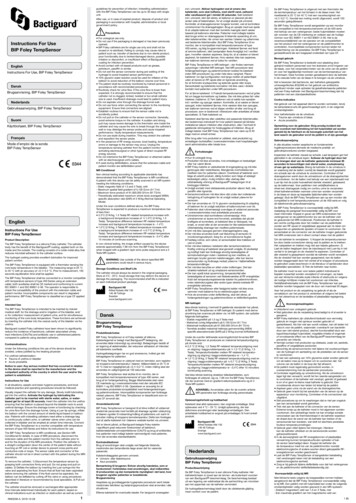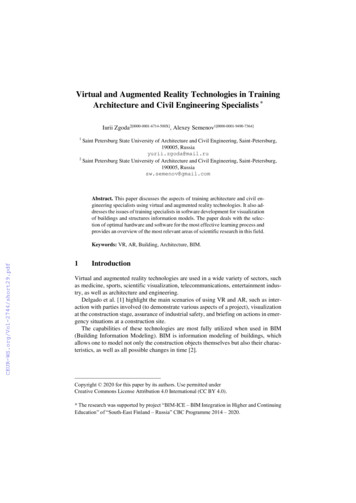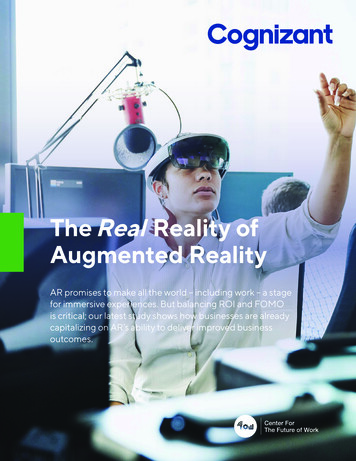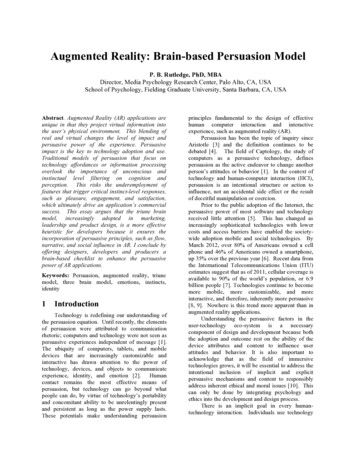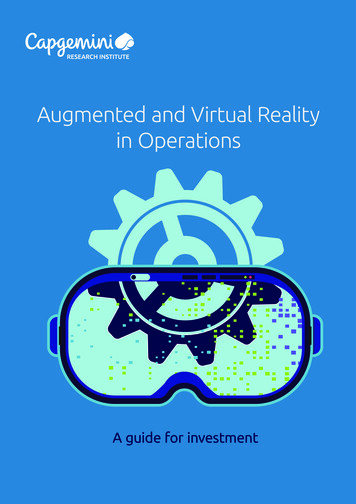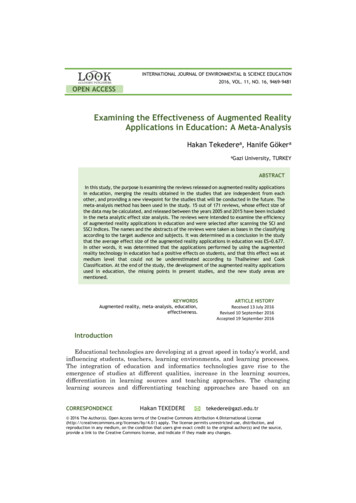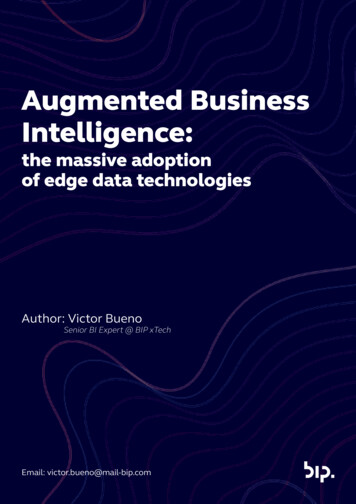
Transcription
Augmented BusinessIntelligence:the massive adoptionof edge data technologiesAuthor: Victor BuenoSenior BI Expert @ BIP xTechEmail: victor.bueno@mail-bip.com1
IntroductionThe idea of collecting data and generating information and KPIs to monitor businessesand measure impacts of strategies, process optimizations and project implementations isnot new to anyone who works in companies oriented to maximize their results. In fact,the connection between KPI monitoring and business management is far well known andeternized in expressions like “what can’t be measured, can’t be managed”, but, as most ofthese managerial statement clichés, it’s not always trivial to collect the right data, to performconsistent data cleansing and to calculate certified KPIs in order to analyse businessperformance and to make correct and timely decisions based on data.The challenge scales-up when talking about big and complex enterprises in which data isgenerated everywhere, where different areas have their own perspectives about processperformances and business trends, considering different data-sources, performing differentdata cleansing procedures and using different formulas to calculate the ‘same KPIs’.It’s in this context that Business Intelligence (BI) solutions became relevant in ICT budgetsmore than a decade ago: ‘why not centralize data management and KPI calculation in ICTteams, to ensure a Single Source of Truth and reduce the effort of business users on datamanipulation activities, making them responsible just for analysing business-ready data?’We all know where this story ended: decentralized data in excel spreadsheets across thecompany.Though (or should we say ‘because’?) this story has failed, in recent years BI solutionsmatured dramatically, finding their space in the so-called edge data technologies, togetherwith the Artificial Intelligence, Advanced Analytics, Cloud solutions, and so on. As a result,Gartner confirmed the trend from previous years and pointed to BI as one of priorities of big1enterprises CIOs for 2021 .BI lives again, long live BI!What is old isnew againIt seems Business Intelligence has really returned to stay (and grow). If at its debut it was allabout centralized and enterprise-level reporting to better organize data across the company,reducing business teams’ ability to analyze data due to ICT-limited capacity to quicklyrespond to their needs, the modern BI solutions brought self-service ad-hoc capabilities tothe masses, improving their front-end features to provide pixel-perfect reports, enabling easydata integration through hundreds of connectors and improving their data manipulationcapabilities for data transformation and KPI calculation, all in an ICT manageable way.But beyond these features, that definitely improved platform capabilities to respond to theprevious objective (“monitor-to-manage”), the most innovative BI solutions captured theirraison-d’être in the edge data technologies environment: the turning-point is the massiveadoption of edge techs by business users.2
DEEPENINGCurrently known as Analytics & Business Intelligence (or Augmented BI), platforms like Power BI, Tableau, Qlik Sense,Thoughtspot, Looker, Microstrategy, Spotfire, Oracle BI, SAP Analytics Cloud, etc. are enhancing their values exploring cloudsolutions, artificial intelligence, machine learning, natural language processing, cognitive engines and augmented experiencefeatures.Figure 1 ABI RoadmapBut what is reallynew?According to Gartner 2, “Augmented Intelligence is a design pattern for a human-centeredpartnership model of people and artificial intelligence (AI) working together to enhancecognitive performance, including learning, decision-making and new experiences”. In otherwords, Augmented Intelligence is oriented to improve, not to substitute, professionals in theirjobs and decision-making processes through the facilitation of understanding and usage of AIwhile playing their roles.ziendali.DEEPENINGThe Augmented Analytics3, in turn, is the “use of enabling technologies such as machine learning and Artificial Intelligence toassist with data preparation, insight generation and insight explanation to augment how people explore and analyse data inanalytics and BI platforms”.Although modern Analytics & Business Intelligence platforms have implemented several newfeatures of Augmented Analytics, in this article we highlight some key innovations that willdramatically impact the way companies consider BI platforms in their ICT strategies:3
Figure 2 ABI Key InnovationsInfrastructureIdentified as one of the challenges for BI platform implementation and enhancement inseveral companies, modern ABI solutions have to be up to date with data and technologytrends, dealing with requirements for storage capacity, computational power and a variety ofenterprise IT architectural blueprints.Cloud Native BICloud is already a reality. In Q3 2020, AWS, Azure and Google Cloud reported a year-overyear growth (YoY) of 29%, 20% and 45%, respectively4 and, according to Forbes and DresnerAdvisory Services in the study “2020 Cloud Computing and Business Intelligence MarketStudy”, a record percentage of enterprises, 54%, say that Cloud BI is either critical or veryimportant to their current and future initiatives5.DEEPENINGPositive sentiment towards Cloud BI saw a sharp upturn in 2018 and it has since risen both in 2019 and 2020, when it climbedfrom 3.22 to 3.4 (well above the level of “important”). Compared to the early years of their focused study, it appears that CloudBI conquered skepticism and crossed a threshold of credibility. Dresner’s research team expects that Cloud BI adoption willcontinue to rise.Cloud Native BI brings strong capabilities to companies thanks to public cloud providers nolonger requiring capital expenditure (CAPEX) on storage and computing and enabling a payper-use logic based on operational expenditure (OPEX) – the more storage and processingyou use the more you pay. Besides, Cloud Native BI easily integrates with Cloud Services totackle real-time data, non-structured data, natural language challenges, denormalized data andSQL querying.Software as a Service (SaaS)Aware of companies’ needs, ABI platforms develop several alternatives of deployment for theirsolutions in different enterprise IT architectures, to the point of providing a full-managedservice in which users just buy their SaaS licenses and then are ready to play.4
DEEPENING6According to the 2020 Gartner Report , the three market leaders, Power BI, Qlik and Tableau, already have their SaaS offerings,and new product launches reinforce this market tendency. Last year, for example, Qlik launched the Qlik Data Transfer7, a free7service to transfer on-premise data to Qlik Cloud in order to boost the adoption of the SaaS version of Qlik Sense Enterprise.AnalyticsThis topic may be considered as one of the most important capabilities of Augmented BIplatforms once it enables business users to deal with data and obtain insights autonomously.DEEPENING8According to Information Week , analytics is entering the mainstream in 2021, which means more enterprise organizationswill be able to take advantage of its benefits to accelerate business intelligence, machine learning, and other forms of artificialintelligence in their organizations, be it more productive projects or faster insights for decision makers.Machine LearningModern ABI tools are looking for ways to better integrate their platforms with machinelearning models to boost data analysis, keeping a low-code approach and increasing MLadoption across companies.At the end of 2020, Qlik announced9 that they are on a journey to provide customers theability to use ML capabilities on their platform, for purposes like optimizing supply chain,improving inventory management, preventing customer churn, etc.DEEPENINGFollowing this strategy, AWS and Qlik have partnered with the joint vision of democratizing predictive analytics by creatingthe Qlik-SageMaker Connector, an integration with Amazon SageMaker, a managed service design to drive and scale the entireML lifecycle, by bridging the Qlik Sense Server and SageMaker Hosting Services. Through the connector, Qlik Sense users cansource real-time predictions from an Amazon SageMaker hosted model through Qlik’s in-memory engine.Tableau, in turn, created the possibility to deploy ML models in Python using the TabPylibrary10, easing ML model output presentation and model deployment in Tableau and making itaccessible to business users. At the end of 2020, in its annual conference, Tableau announced itsplan to bring together Tableau and Einstein Analytics11, both of Salesforce.Planned for the first part of 2021, Einstein Discovery in Tableau enables real-time predictivemodelling and recommendation capabilities across the Tableau platform11.DEEPENINGAccording to the company, “Tableau and Einstein Analytics will come together through a set of product integrations that willprovide a more seamless experience for joint customers”.Einstein Discovery helps companies democratize data science across their organization with AI-powered analytics that enablebusiness users to automatically discover relevant patterns based on their data.In this context, Microsoft, the BI market leader, is boosting ML capabilities on Power BI throughnative integration with Azure. Still in 2019, Santosh Chandwani, Principal PM of Power BI,announced the preview of Automated Machine Learning (AutoML) for Dataflows in Power BI.5
AutoML enables business analysts to build machine learning models with clicks, not code, usingjust their Power BI skills.DEEPENINGWith AutoML, the data science behind the creation of ML models is automated by Power BI, with guardrails to ensure modelquality, and visibility to ensure you have full insight into the steps used to create the ML model. Following the Cloud Nativetendency, this functionality is only available on Power BI Premium and Embedded, both enterprise cloud-based licenses ofPower BI 13.Cognitive BIFollowing the tendency of ML enhancements on ABI platforms and exploring Cloud Services, wecan say that Cognitive BI solutions are like a young brother of the previous innovation with astill modest adoption.DEEPENINGGartner projects that, by 2025, AI for video, audio, vibration, text, emotion and other content analytics will trigger majorinnovations and transformations in 75% of Fortune 500 global enterprises 8.Aware of this other tendency, modern ABI tools are already integrating text analyticscapabilities in their platforms, providing connectors to web and social media data andperforming entity recognition and sentiment analysis.DEEPENINGIn 2020, Power BI announced the inclusion of semantic search functionalities in its roadmap 14.Data RelationshipsFirst created by Qlik, the Associative Engine was designed specifically for interactive, freeform exploration and analysis, with the ability to fully combine large numbers of data sourcesand index them to understand the associations.DEEPENINGWith this characteristic, any user – at any skill level – can search and explore their data in any direction, following their curiositywherever it leads. According to Qlik, “it’s like having peripheral vision, removing blind spots and uncovering hidden insights thataren’t available in query-based tools” 15.Well, as with most successful innovations on the market, solutions oriented to automatically understanding connectionsbetween data were launched, like the Semantic Graph of Microstrategy16 that, together with the Hyperintelligence feature, putMicrostrategy as a Challenger in Gartner’s 2019 Report on ABI.”Insight GeneratorAs previously mentioned, to succeed in their adoption across enterprises, ABI platforms hadto be ready to provide self-service BI environments, enabling business users to perform theirown analyses instead of being “locked” on pre-made dashboards. Recent studies highlight thatusers often don’t want to self-serve; they increasingly expect insights to come to them. AIwill play a major role here, surfacing micro-insights and helping us move from scripted andpeople-oriented processes to more automated, low-code and no-code data preparation andanalytics 17.6
DEEPENINGRegarding this, Thoughtspot provides an innovative solution based on the following pillars: Spot IQ and Search Engine. Spot IQconsists in an engine able to perform thousands of queries into underlying data and autonomously provide insights to users.The engine’s performance is improved by its ML model oriented to self-training, based on user evaluations of the generatedinsights. Finally, with its Search Engine, users no longer need to calculate KPIs manually, but they can simply ask the platformdirectly using natural language18.In the second semester of 2020, Qlik announced its Insight Bot, which is an AI-powered conversational analytics experience,oriented to giving everyone a faster and easier way to ask questions, get insights, and make data-driven decisions using naturallanguage19.Conversational BIIn the evolution to Natural Language, why not also consider the possibility of Conversational BI?crystal, an augmented analytics tool by Milan-based scaleup iGenius, allows users to submitquestions via voice or text: crystal translates these into queries on a relational databaseand responds in real time. Responses will be served up via voice or charts, based on the dataretrieved. crystal can understand concepts such as aggregation, averages, filters, data pivoting,depending on how questions are formulated.DEEPENINGThe platform’s AI is able to recommend follow-up questions or NBQ (Next Best Questions) to users, based on history of use.Crystal can be configured quickly and in a way that is tailored around users’ specific needs, thanks to a “no-code low-code”configuration console. The product is currently available in English and Italian.Figure 3 crystal in actionShareRegarding this topic, important changes are expected in the way professionals communicateresults and insights. In a context of increased collaboration activities, professionals need moredynamicity to easily share information, receive feedbacks and improve.Data StoriesData stories consists in the setup of a guided dynamic flow into a dashboard analysis toperform a storytelling that can be interactive and progressive, keeping the audience engaged7
without the need to create long presentations.Currently, the main ABI players already offer data stories functionality, but its usage isn’tmassive among business professionals. Rita Sallam, Gartner VP analyst, highlights that datastories can help move organizations beyond the dashboard paradigm to a new way ofconsuming insights and sharing them across the companies.DEEPENING“By 2025, data stories will be the most widespread way of consuming analytics,” Sallam said. “Seventy-five percent of thosestories will be automatically generated using augmented analytics techniques 8.”Decision Support SystemsDecision support systems (DSS) are solutions designed to enable data consolidation fromdifferent and heterogeneous source systems into a unique server providing users the abilityto query and monitor these sources through data analysis, KPIs and video flows.The multi-touch tables, in turn, are one of potential channels in which DSS can be deliveredand it consists mainly in a hardware component with adapted software based on the NaturalUser Interface (NUI) paradigm to enable interactive multi touch screen system as tables &walls with customized touchscreen software & object recognition technology.DEEPENINGKeyBiz is one of the high-tech companies developing advanced DSS solutions integrated with IoT devices providing hardwarecomponents adapted with NUI software development paradigm. The company designed multi-touch tables proposedspecifically to sales and operations monitoring, war-rooms and rooms for crisis management in which users need dynamicity todive into data and KPIs to better analyse challenges from multiple points of view.Below we present an example of Metamorphosis dashboard that is a KeyBiz DSS solution based on IoT devices and to monitoroperations in real-time.Figure 4 Multi Touch Table ExampleFigure 5 KeyBiz Metamorphosis DSSCurrently designed for single users, with the large adoption of multi-touch tables byenterprises, the modern ABI platforms will have to include this capability in their rangeof products/functionalities to play an important role in the Next Generation of DecisionSupport Management, strongly based on data visualization and collaboration capabilities8
Where to start?The old Business Intelligence has dramatically evolved in recent years, going beyond datamonitoring in well-designed dashboards to enabling companies to boost adoption of edgedata technologies across areas. The point here is whether people in companies are reallyready to adopt edge data technologies and fully explore their capabilities in the AugmentedIntelligence era.At Bip, we understand that this readiness is not a starting point, but a result from atransformation program. Our approach to supporting companies towards ABI consists inthe design of use-case-driven evolutionary roadmaps that will guide the enhancement of BIplatforms, data infrastructure and Users’ culture and attitude.Bip xTech, our Center of Excellence in exponential technologies, can count on BI experts, datastrategists, data scientists and other data professionals ready to support this evolutionarypath, being able to help our clients from the standardization of reports and development ofmain corporate dashboards up to the governance of an ABI program and the development ofenhanced ABI solutions through AI, ML and streaming analytics.DisclaimerIn this article, some products/vendors have been mentioned as examples to illustrate someadvanced functionalities. Bip, through our center of excellence in data technologies (Bip xTech),has partnerships with many of these vendors but, aligned with our vendor independencestrategy, we maintain as technology agnostic and, therefore, we are able to recommend thebest solution depending on the client need, leveraging on a group of experts certified in mostof these technologies.IF YOU NEED AN INSIGHT ON OUR END-TO-END OFFERING OR YOU WISH TO HAVE ACONVERSATION WITH ONE OF OUR EXPERTS, PLEASE FILL IN YOUR PERSONAL DATA ATTHIS LINK, AND YOU WILL BE CONTACTED SOON.9
lossary/augmentedintelligence#: :text gmentedanalytics#: :text h datasheets/dsqlik-insight-bot-en.pdf10
5 Analytics This topic may be considered as one of the most important capabilities of Augmented BI platforms once it enables business users to deal with data and obtain insights autonomously. Tableau, in turn, created the possibility to deploy ML models in Python using the TabPy library10, easing ML model output presentation and model deployment in Tableau and making it
